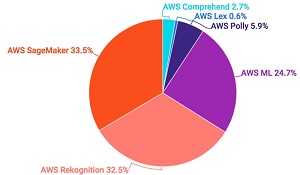News
Cloud Report: AI/ML, Serverless, Flash Storage on Rise
A report from cloud spending and management company Cloudability shows today's cloud services have come a long way since Amazon Web Services debuted in 2006, demonstrating the growth of new-age offerings like artificial intelligence/machine learning, serverless computing, flash storage and more.
While the report focuses primarily on dominant industry leader AWS, it also contains some cloud spending and usage data on other providers, such as Microsoft Azure.
Though the growth of the aforementioned modern services is cited as one of the key takeaways of the report, Cloudability also highlighted the concentration of services that companies are spending their cloud money on.
It found that that 85 percent of spend is concentrated in four services: AWS EC2 (cloud compute), EBS (Amazon Elastic Block Store), RDS (Amazon Relational Database Service) and S3 (Amazon Simple Storage).
"However, cloud adoption has only scratched the surface in the IT infrastructure market; it's estimated that only 10 percent of all workloads have moved to the cloud," the report said. "Given the large share of compute, it's clear that 'lift-and-shift' migrations continue to dominate cloud adoption."
That cloud adoption is increasingly featuring the usage of the modern technologies listed above. Here's what Cloudability had to say about some of them.
- Serverless computing starts to take a bite: Serverless growth across AWS Lambda and Microsoft Azure functions continues to see a rapid quarter over quarter growth. Serverless continues to be attractive to organizations since it doesn’t require management of the infrastructure. As companies migrate increasingly to the cloud and continue to build cloud-native architectures, we think the pace of serverless adoption will also continue to grow.
- Flash is gaining more adoption for block storage: With SSDs now available in Terabytes (TBs) and high IOPSs, we see most of the storage growth in SSDs. SSDs with Provisioned IOPS also grew at a similar rate, with organizations moving more of their high-performance workloads to the cloud. Because of this, customers can be increasingly comfortable with deploying their most important, high-performance workloads in the cloud.
- AI/ML instances are growing at a rapid clip: We continue to see high growth rates related to GPU-based instances, even though it’s a smaller percentage of the overall spend on compute. As companies start to further explore and invest in machine learning capabilities, we expect to see this growth continue.
As cloud provider offerings make it easier for companies to leverage the extensive capabilities of AI/ML we anticipate these technologies being used for driving improved customer experience, increased efficiency and address some of the toughest business challenges.
 [Click on image for larger view.] Popular AWS AI/ML Services (source: Cloudability).
[Click on image for larger view.] Popular AWS AI/ML Services (source: Cloudability).
In the AI/ML arena, Cloudability noted the heavy use of AWS SageMaker for developing and iterating on training models. Related to that, heavy adoption of AWS Rekognition reveals organizations are using image and video analysis in the search of deeper insights for users. AWS ML is the third-most used service in this category.
The report also noted:
- Compute capacity continues to grow at a rapid clip. Because of increased application performance requirements, the hours of vCPUs consumed grew by 85 percent over the last year.
- Organizations continue to provision most of their compute workloads on General Purpose instances (t1, t2, m3, m4, and m5).
- Application architectures are increasingly using cloud-native capabilities.
- The industry continued to converge on Kubernetes (K8s) for container orchestration, with Mesos as the other major player.
- Open source databases are clearly the favorite option for organizations, with MySQL leading the pack, followed by PosgreSQL, SQL Server and Oracle.
The methodology backing the report included the analysis of company data from more than 1,500 organizations with over $2.5 billion in spend in 2017, resulting in a data set exceeding 75 billion data points, 3 billion CPU hours and 700 million unique compute resources.
About the Author
David Ramel is an editor and writer at Converge 360.